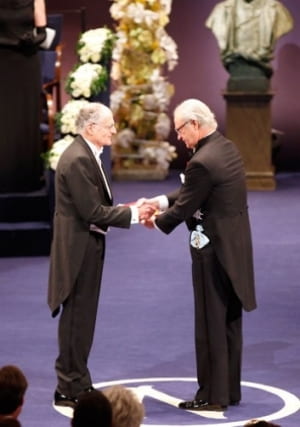“(HPC) machines have made it possible for us to solve problems that simply couldn’t be approached without them.” – Professor Thomas J. Sargent
By Kit Westneat

Those of us who work, study, and teach at NYU know that it is a world-class research university, but it is still quite exciting when one of our own is internationally recognized for excellence and leadership in their field. The NYU High Performance Computing (HPC) team, like all of ITS, is dedicated to supporting and facilitating research, teaching and learning. We were therefore thrilled to learn that the most recent Nobel Prize in Economics was awarded to NYU professor Thomas J. Sargent, who relies on our HPC systems for his research.
On October 10th, 2011, professor Sargent and Princeton University professor Christopher Sims were honored by the Royal Swedish Academy of Sciences with the Noble Prize in Economics for “empirical research on cause and effect in the macroeconomy.” Their use of statistical methods to disentangle the complex variables that govern economic behavior have given policy makers new tools to help understand the way government policies affect the economy. Sargent’s work specifically focuses on long-term structural changes, and he has worked on analyzing historical data to discern cause and effect for economic events. He joined NYU in 2002 as the first W.R. Berkley Professor of Economics and Business and has been using NYU’s HPC resources for some time.
The mission of NYU’s HPC service is to enable and support NYU faculty, researchers and students in their research by providing advanced computing technologies. The types of research supported are quite diverse—from chemistry and physics to math and economics—but all need robust computational resources to process, store, analyze, and visualize large sets of data. HPC resources are open to NYU faculty, staff, and faculty-sponsored students, and may be used for class instruction. For more information, see the High Performance & Computational Resources page.
Professor Sargent used the HPC machines to compute and estimate large-scale dynamic stochastic equilibrium models, using a class of iterative equations known as Bellman equations, and for doing large-scale Bayesian estimation using Markov Chain Monte Carlo functions. These equations, and the machines that calculate them, allowed Sargent to use new models to describe rare events and to model uncertainty and the aggregate effects of welfare states based on benefit levels and tax burdens. The large memory capabilities provided by HPC can run models that would be impossible on standard personal computers. Large simulation models can be computed that “would take weeks to run without using HPC.” As Professor Sargent says, “The HPC machines have helped us cope with the ‘curse of dimensionality’ that limits both types of computations. (HPC) machines have made it possible for us to solve problems that simply couldn’t be approached without them.” Our congratulations to Professors Sargent and Sims on their remarkable accomplishment! We look forward to seeing what revolutionary research our HPC resources can help enable next.
About the Author
Kit Westneat is a System Administrator in the ITS .edu Services’ eSystems Group and a member of the NYU High Performance Computing team. To contact the HPC team, send e-mail to hpc@nyu.edu.